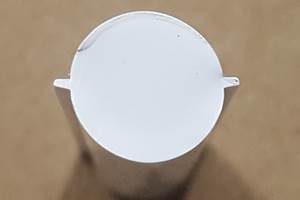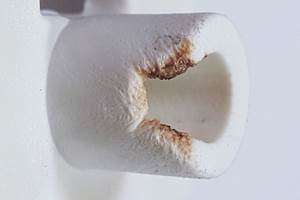In Single Screw Extruders, Mixing Starts in the Melting Process
While the melting process does not provide perfect mixing, this study shows that mixing is indeed initiated during melting.
The melting process for plasticating, single-screw extruders is also an excellent mixing process. A low level of mixing can occur during pellet blending before being placed in the hopper. But the first major mixing process occurs during melting.

Figure 1 – ABS resin in the transition section after a Maddock solidification experiment. The feedstock mixture was 200 parts white ABS and one part black ABS in pellet form. Source: M. Spalding
This mixing is obvious by studying the photograph in Figure 1. Here the feedstock was a mixture containing 200 parts of a white ABS terpolymer to one part of black ABS, both in pellet form. The cross section was taken from a Maddock solidification experiment where the feedstock was extruded and then the screw rotation was stopped. Next, full cooling was applied to the barrel.
After the ABS was solidified and at room temperature, the screw and plastic were pushed out of the barrel, and the plastic was cut off the screw. The areas that are white were solid, compacted pellets when screw rotation was stopped. The melting process occurred mostly in a thin melt film between the solid bed and the barrel wall. The molten resin was then conveyed to the melt pool by the rotation of the screw.
At the 200:1 ratio noted, the concentration of black pellets was so low that not a single black pellet is observed in the white region of Figure 1. The rotation of the screw causes energy to be dissipated in the melt film via high shear rates and shear stresses. The thickness of the melt film is between 0.010 and 0.020 inches. The energy dissipated conducts into the solid bed and melts the resin at the solids-melt film interface. The high shear stresses cause the mixing process to occur in the melt film. The melt pool where the freshly melted resin accumulates is relatively uniform in color, indicating the effectiveness of the mixing process during melting.
As shown, color striations between gray and black bands exist, indicating that mixing is not perfect. But going from a feedstock of mostly white pellets to a melt pool that is essentially black indicates the melting process is a great mixing process.
The excellent level of mixing occurs because the melt film is very thin, causing a high level of material elongation during melting. For example, the velocity of the solid bed is on the order of a few cm/sec in the downstream direction. When melting at the interface occurs, the molten material is stretched and accelerated in the cross-channel direction at a velocity nearly 10 times higher. Moreover, materials from many pellets are accelerated and mixed at the same time. Statistically, about 1/220 of the area at the melt film-solid bed interface would have a black pellet, yet the material at the entire surface at the barrel wall is tinted black once melting has started, as shown by Figure 2.

Figure 2 – A screw from a Maddock solidification experiment.
In this figure, the first three diameters of the screw do not contain any plastic. Here the pellets were at ambient temperature and very low pressure such that the pellets would not compact into a solid bed. They fell off the screw and to the floor when the screw was removed from the barrel. At diameter 4, the pellets were compacted but have not started to melt as indicated by the white color. That is, no melting and no mixing. By diameter five and all diameters downstream, the outside surface of the plastic was tinted black due to mixing during melting.
The melting process, however, does not provide perfect mixing, as shown by the melt pool in Figure 3. As melting occurs in the melt film, it is dragged over into the melt pool. The material entering the melt pool from the melt film creates a recirculation flow counterclockwise, creating color striations. These striations are clearly visible in Figure 3. For many applications, these striations would cause color defects in the final product. This imperfect mixing can be completed using a secondary mixing process such as a Maddock mixer positioned near the discharge of the screw. Operation and design of Maddock mixers was discussed in the March 2024 issue of Plastics Technology.

Figure 3 – Blowup of the melt pool in Figure 1 with the counterclockwise flow shown by the arrow.
The Maddock solidification experiment presented here clearly shows that primary mixing occurs during the melting process. The mixing occurs because of the thin melt film between the compacted solid bed and the barrel wall where the shear rate and shear stress are high. A secondary mixing process is needed downstream to guarantee a homogenous extrudate before forming the final product.
About the Author: Mark A. Spalding is a fellow in Packaging & Specialty Plastics and Hydrocarbons R&D at Dow Inc. in Midland, Michigan. During his 39 years at Dow, he has focused on development, design and troubleshooting of polymer processes, especially in single-screw extrusion. He co-authored Analyzing and Troubleshooting Single-Screw Extruders with Gregory Campbell. Contact: 989-636-9849; maspalding@dow.com; dow.com.
Related Content
Understanding Melting in Single-Screw Extruders
You can better visualize the melting process by “flipping” the observation point so the barrel appears to be turning clockwise around a stationary screw.
Read MoreWhere and How to Vent Injection Molds: Part 3
Questioning several “rules of thumb” about venting injection molds.
Read MoreThe Fundamentals of Polyethylene – Part 2: Density and Molecular Weight
PE properties can be adjusted either by changing the molecular weight or by altering the density. While this increases the possible combinations of properties, it also requires that the specification for the material be precise.
Read MoreBack to Basics on Mold Venting (Part 1)
Here’s what you need to know to improve the quality of your parts and to protect your molds.
Read MoreRead Next
People 4.0 – How to Get Buy-In from Your Staff for Industry 4.0 Systems
Implementing a production monitoring system as the foundation of a ‘smart factory’ is about integrating people with new technology as much as it is about integrating machines and computers. Here are tips from a company that has gone through the process.
Read MoreFor PLASTICS' CEO Seaholm, NPE to Shine Light on Sustainability Successes
With advocacy, communication and sustainability as three main pillars, Seaholm leads a trade association to NPE that ‘is more active today than we have ever been.’
Read MoreLead the Conversation, Change the Conversation
Coverage of single-use plastics can be both misleading and demoralizing. Here are 10 tips for changing the perception of the plastics industry at your company and in your community.
Read More





















